Keywords: ADSI protocol, fixed telephone, short message system, CTI technology
1 Introduction
1.1 Background and goals of system construction Today's society is an era of information explosion, people have increasingly needed to obtain information quickly and accurately in their daily work and life. The emergence of various advanced communication tools, such as the Internet, mobile phones, and BP machines, has met the needs of people at different levels. However, no matter what, the local network telephone is still the most popular means of communication. Its popularity and ease of use make it have long-term vitality.
The telecommunications industry is an industry that provides services to society, and services are the foothold of the telecommunications industry. In the market economy environment, in order to meet the market competition from home and abroad, China Telecom must better improve the service system of the enterprise and continuously launch new value-added services to enable it to face the gradual opening of the national telecommunications market. Competition against foreign telecommunications giants can be invincible.
At present, for local telephone users, China Telecom has launched many value-added services, such as 168 sound station, telephone banking, and number 1000 services, which have brought great convenience to people's daily lives. However, due to the inherent limitations of ordinary telephones, it has prevented the further development of value-added telecommunications services. At the same time, the rapid development of the Internet, the explosive growth of the number of netizens, and the continuous enrichment of information means have brought new challenges to telecom operators. How to unify all kinds of information on one platform is currently a hot topic.
The goal of the fixed telephone short message system is to absorb advanced experience at home and abroad, combined with the actual situation of China Telecom, based on the construction of the local network telecommunications business system, using advanced signaling technology, database technology, Internet technology to establish a level A structured, well-functioning fixed-line SMS intelligent platform.
1.2 System Features The basic features of the fixed phone short message intelligent platform are as follows:
· Adopt high-performance communication platform;
· Adopt high-performance server system;
· Use Dialogic digital network interface template;
· Support China No. 1 signaling;
· Provide billing function;
· Adopt standard open interface;
Support the interconnection of multiple local network short message intelligent platforms to achieve balanced traffic and improve the efficiency of system resource use;
· Complete real-time management system, providing system management, fault alarm and diagnosis functions;
· Provide graphical interface management tools;
Provide a variety of development tools.
2 System Architecture The fixed telephone short message intelligent platform is composed of three parts:
· Intelligent communication platform: PSTN server, short message server;
· External subsystems: SMS subsystem, paging subsystem, EMAIL subsystem, INTERNET subsystem, etc .;
· Smart terminal: Smart phone, other compatible smart terminal. The separation of the user server and the PSTN server means the centralized management of users and information and the distributed use of PSTN equipment, which greatly improves the expansion ability of the PSTN channel. The PSTN server of the intelligent platform uses Intel's Dialogic digital network interface template to receive or make outgoing calls through one or two E1 lines. A single PSTN server supports up to sixty telephone signal calls at the same time. In order to increase the system capacity, only need to increase the PSTN server. Because the user server is separated separately, it also has strong user support capabilities.
The network communication part adopts a communication platform based on short connection technology to save server resources and make the communication stable and reliable. ORACLE is used as the user database of the intelligent platform, which supports a large number of users to access at the same time.
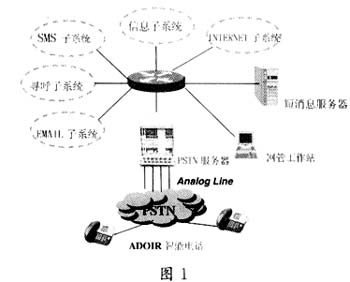
The system architecture is shown in Figure 1.
3ADSI Protocol The predecessor of ADSI (Analog Display Service Interface) protocol is a user interface protocol based on network services developed by Nortel and BellSouth in 1988. In 1992, Bellcore (now Telcordia Technologies) announced ADSI as a national standard. Based on the existing CLASS (Custom Local Area Signaling Services) technology that supports caller ID, ADSI allows more advanced screen-based applications and interactivity, turning the phone into a powerful communication device. If there is no unified standard, users need to use different devices to use different services. With the ADSI specification, users can use a screen-based phone to customize different services, including (but not limited to) home banking, stocks, news, mail, advanced calling services, and other web-based services. The ADSI protocol allows interactive voice and data to be transmitted over existing telephone lines in the public network without the need for additional special equipment support.
3.1 Advanced Call Management Services (Advanced CallManage-mentServices)
Telephone-based services such as: Caller ID (Caller ID), Call Waiting Display (CallWaiTIng Display) and Deluxe Call Waiting Display (Deluxe Call WaiTIng Display) provide service providers with call display capabilities through CLASS. Advanced call management services provide an improved display-based interface, and through CLASS and customized call features (CCF) such as: repeat dialing, automatic callback, screen list editing, three-way calling, call forwarding, speed dialing and cancel call waiting Wait to guide the user. It still supports display-based services such as call waiting display and luxury call waiting display.
3.2 Abstract CPE concept The core of the ADSI protocol is the concept of abstract CPE (customer home equipment), describing how abstract client devices are displayed, soft keys (Softkey) and how to interact with the server. Before introducing the abstract CPE concept and the ADSI protocol, first introduce two different types of ADSI sessions: Server Display Control and Feature Download.
(1) Server Display ControlSession
The server interacts with the ADSI phone through the server display control session. The server sends information and soft keys to the phone, and the user responds by typing on the keyboard and pressing soft keys. The interaction process is similar to the user and the interactive voice response system (IVR). Services include home banking, directory services, news, stocks, etc., and can support an unlimited variety of application services.
(2) Feature Download Session
No server interaction during the featured download session. Scripts residing in ADSI phones are activated according to the state of the phone. For example, in a three-party call, when a call occurs, the phone recognizes that the status activation script provides soft keys that can activate the three-party call. When the soft key is pressed, the displayed content changes to instructions on how to proceed to the next step. Since the script resides on the phone, the number of scripts must be limited. Although only one script is required, the Bellcore specification suggests that four scripts can reside on the phone.
3.3 ADSI protocol stack The ADSI protocol was defined by Bellcore in 1992. The agreement specifies the information service interface requirements between the ADSI terminal and the ADSI server. It uses the FSK method when the server sends information to the terminal, and the terminal uses DTMF when confirming information or sending new information to the server. The protocol stipulates the message format, encoding method, interactive signaling requirements, and so on. The protocol stack can be divided into three layers: physical layer, data link layer and message layer.
The ADSI protocol provides a standard for two-way data communication between the customer's home equipment (CPE) and the server on the analog telephone line. It uses DTMF signaling technology, FSK modulation technology, and uses calling display technology at the same time, and expands the content, display method and control means of information display.
(1) Physical layer This layer is responsible for the transmission of the physical data unit (bit stream) between SPCS / SERVER and user MODEM through the interface. Including the physical, electrical performance and transmission requirements of DTMF and FSK signaling.
· SPCS / SERVER to CPE direction:
SPCS / SERVER is required to generate CAS (CPEAlert Signal) to prompt CPE to pick up the phone;
SPCS / SERVER is required to produce standard dial tone and other call progress tones.
· PE to SPCS / SERVER direction:
SPCS / SERVER can receive standard DTMF signaling and 15 DTMF tones (except DTMFC);
SPCS / SERVER can receive DTMF signals with a duration of 55-70ms, with an interval of 45-70ms or a duration of 25-50ms, with an interval of 45-70ms;
For ADSI, SPCS / SERVER should be able to detect the DTMF confirmation signal after the FSK data burst and before the next burst, or other CPE responses to certain commands.
(2) Data link layer This layer makes full use of available bit rates to provide reliable data transmission with SPCS / SERVER and CPE, and performs error detection and correction. The functions are as follows: establish and release the data link between SPCS / SERVER and CPE; detect the transmission error in CPE, (SPCS / SERVER end optional) correct the transmission error by retransmitting the information that was CPENACK.
The frame format of the ADSI data link layer from SPCS / SERVER to CPE is as follows:

Message Number Word is defined as follows: This field indicates the number of the message sent to the CPE in the multi-message format data burst. The message number field is one byte long, and its value range is expressed in binary numbers 1 to 5. This allows five consecutive messages to be sent without receiving an ACK.
Checksum Word is defined as follows: This field is the message type, length, message number (Message Number), and all three layers of data such as all parameter types, lengths, and the modulo 256 sum of parameter data words.
(3) Message Layer
The message layer handles the character set, the data codes used, and the display of the data on the CPE. The format of the command parameter message sent from SPCS / SERVER to CPE is as follows:

3.4 The 8-bit character coding table expressed by DTMF signal is shown in Table 1 for the 8-bit character coding table expressed by DTMF signal.
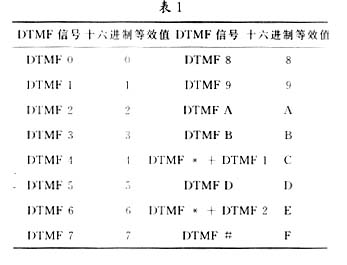
4 System structure diagram The short message service system platform is a server that provides information services for short message terminals. The functional entity diagram is shown in Figure 2
4.1 Description of functional parts 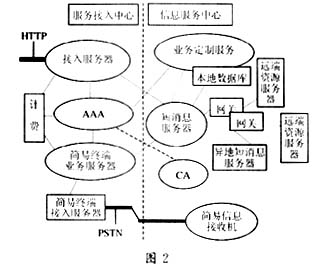
· Simple information receiver: an auto-running component that can complete the work that a simple terminal can complete. In the case of no human intervention, it can automatically identify the information download request from the server, pick up the phone, accept the information, and generate a prompt message to inform the end user that a short message is coming. In addition, the download information can be edited and forwarded.
· Simple terminal access server: Access server for information exchange according to ADSI (AnalogDisplay Server Interface) protocol. Complete the work of the physical layer and data link layer of the ADSI protocol. It sends information in FSK mode, accepts information from the terminal in DTMF mode, and uses DTMF as signaling service; it can generate CAS (CPEAlerting Signal) to notify the terminal to work . The server is also connected to the AAA server (signing authority, authentication, accounting) through the Radius interface protocol to provide AAA services for the terminal.
· Simple terminal service server: organize and assemble data according to the requirements of the ADSI protocol message layer. Send it to the simple terminal interface server. At the same time, the server is also connected to the short message server, which provides the destination and content of the information download to the former.
· Short message server: This server is the core of this system, which completes the acquisition, organization and forwarding of information. First, it obtains the user's information service requirements from the user's service customization server, and then obtains the information required by the user from the local resource database or the remote resource server, and sends the information to the simple terminal server according to the user's requirements (time, destination) . In addition, the short message must accept the short message transferred from the short message server in different places to send to the local user; or send the short message of the local user.
· Business customization server: for users to access, used to customize different short messages, such as: weather, traffic conditions, news, magazine summary, etc. Provide processing requirements for users' short messages, such as: blacklist input limitation, definition of information acceptance group, group sending, short message collection, etc. The customized server gives the service sending and receiving information while giving the service selection. The service customization server has an interface with AAA to determine whether the user has the right to enjoy the service.
· Gateway: This is a group of protocol conversion servers connected to external servers. These external servers include: remote resource servers (Web servers, FTP servers, and other types of ISP servers) and remote short message servers. They exchange information according to HTTP, FTP, SMPP and other protocols.
· Remote resource server: provide the information required by the customized service for the short message server. The system can be connected to various resource servers through a gateway to obtain various information.
· Remote SMS server: including the same type of short message server and different types of short message servers, so that users connected to this information platform can send short messages to users located on other service platforms. Remote short message server can serve PSTN network and mobile network.
· AAA server: used for user authentication, signing rights, and accounting. The charging here is to provide a log of user information traffic.
· Accounting server: According to the user information service type log provided by the business server, and AAA log records, the user can be charged with different requirements.
4.2 System configuration diagram The system configuration diagram is shown in Figure 3. 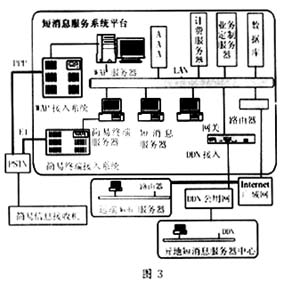
4.3 Interface description In this system, according to the concept of ADSI protocol, the simple information receiver is the ADSI terminal, and the simple information access server and the simple information service server are the ADSI server. The simple information access server completes the work of the ADSI physical link layer and network layer, and the simple information service server completes the work of the ADSI application layer.
First, the simple message access server dials a designated user. The user's simple message receiver recognizes the calling number, confirms that it is service from the server, automatically goes off-hook, and the normal voice channel is established. Then, the server sounds CAS, and the receiver responds with DTMFA to establish the ADSI information service channel. After that, the server continuously sends information to the receiver. If the acceptance is successful, the receiver reports DTMFD1 to the server. If it fails, it sends D0 to request the server to retransmit the information.
The receiver continuously processes the commands from the server and accepts the download of short messages.
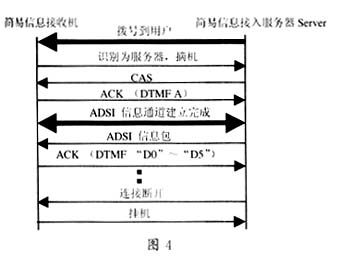
The schematic diagram of information transmission is shown in Figure 4.
5 Conclusion In view of the fact that our country is still a developing country, there are still a considerable number of families who cannot afford a computer, or cannot afford the Internet access due to a computer, or, although economically affordable, it is difficult to get used to the computer due to their cultural qualities . Therefore, the fixed telephone short message system has great market potential and development space.
references
2 Bellcore Co. , LSSGR Co. Voiceband Data Transmission Interface Section 6.6 (GR-30-CORE) FR-NWT-000064 Issue 1. Bellcore Co. , December 1994
Circuit Board Parts,Circuit Board,Printed Circuit Board,Socket Circuit Board
Dongguan baiyou electronic co.,ltd , https://www.dgbaiyou.com